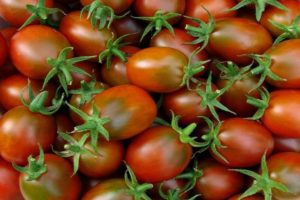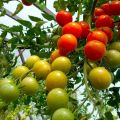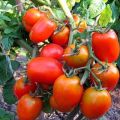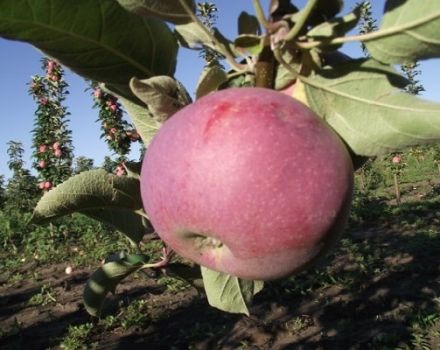Characteristics and description of the Mikado tomato variety, its yield
Pink Mikado tomato is the most famous variety of the Mikado tomato series. Large, juicy fruits are characteristic of any variety of this series. It is for the size of Mikado tomatoes that vegetable growers appreciate.
Color variety
Almost in any store specializing in seeds, you can find the entire line of Mikado tomatoes. All tomatoes are large-fruited, and the main difference is color.
As a result of the work of breeders, tomatoes of different colors were obtained:
- pink;
- yellow;
- red;
- black.
The most unusual of this series is the black Mikado tomato. Black-fruited species are obtained through normal selection work, which has been carried out for many years. The material for crossing is varieties with red fruits and certain types of wild-growing tomatoes.
Black color is a sign of increased sweetness. Fruits weigh 250 - 300 g. All Mikado tomatoes have common parameters of yield, growth, weight, ripening period.
Pink
Pink Mikado is an early maturing plant. It takes 90 days for the fruit to ripen. Tomato bush of indeterminate type. In the greenhouse it grows up to 2.5 meters. Form a bush into one stem. The variety description contains planting recommendations. Necessary density for planting is negotiated - 3 plants per 1 m².
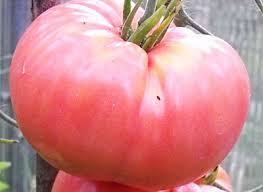
Photo of Pink Mikado is impressive. The weight of the first fruits can be up to 600 g, the average weight of the fruits harvested from one bush is 300 g. Due to the dense skin and pulp, pink fruits can be stored for a long time and not be damaged during transportation.
Yellow
Tomato Mikado golden - mid-season plant. Fruits from seedlings ripen in 120 days. Bushes are tall, indeterminate type. The description contains recommendations for growing conditions.
Mikado Golden must be grown in greenhouses. This species is resistant to weather changes. Flat-round yellow fruits are used in salads or put on juice. Their weight is remarkable - 500 g.
In shops you can find seeds of tomatoes Mikado yellow. The color of the fruit and the main characteristics of the golden and yellow Mikado are the same, but in terms of ripening, yellow ripens later. Refers to late-ripening plants (140 days).
Red
Mikado red is a medium early variety. Harvesting begins after 110 days. Standard plant. Bushes with potato-like leaves grow just above 1 m.
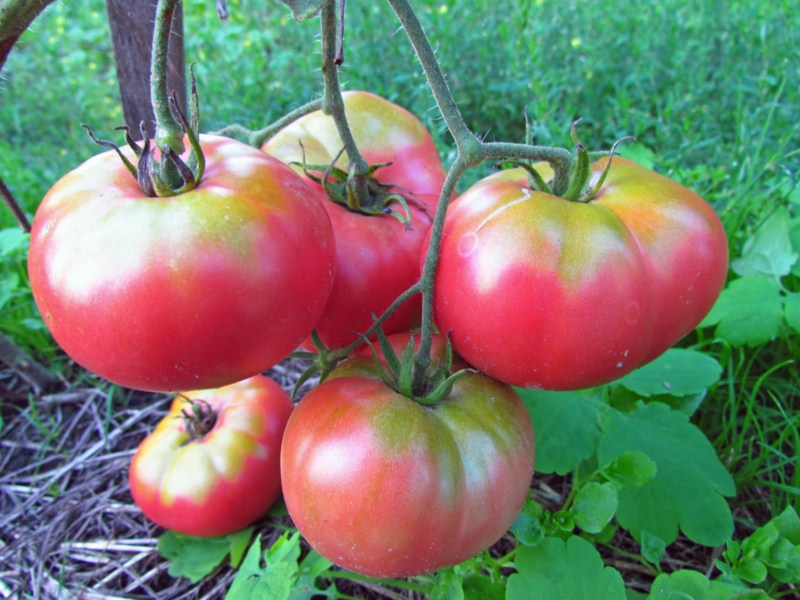
There are no restrictions for growing in soil. Summer residents get good yields both in greenhouses and in a vegetable garden. Ripe fruits are typically maroon in color. Tomatoes are rounded, slightly flattened, shallow folds are noticeable around the perimeter. The taste is sweet due to the high percentage of sugar.
Vegetable growers about Mikado
Anyone who planted Mikado will certainly agree with the opinion of amateur vegetable growers. Their reviews can influence the choice of a variety.
Sergey, 52 years old, Yekaterinburg:
“After reading the reviews, I decided to plant Mikado today. I bought a red one from Gavrish. The variety pleased me, but because of the prolonged rains, many tomatoes have rotted. "
Vera, 34 years old, Moscow:
“The characteristic and description of the Mikado variety is correct. I have been growing red Mikado for several years now. Satisfied with everything: yield, tomato taste. There are no complaints about seed germination and seedling quality. The seedlings are always strong. "
Lyudmila, 67 years old, Voronezh:
“I have been growing Mikado tomatoes for several years. I sell tomatoes on the market, there is always a demand. In the spring I sell seedlings, which also quickly disperse. "
Growing tips
Each variety of tomatoes has features of care and planting. A good harvest of Mikado tomatoes is not so easy for a beginner to grow. According to the reviews of experienced gardeners, the agricultural technology of this type of tomato is complex.
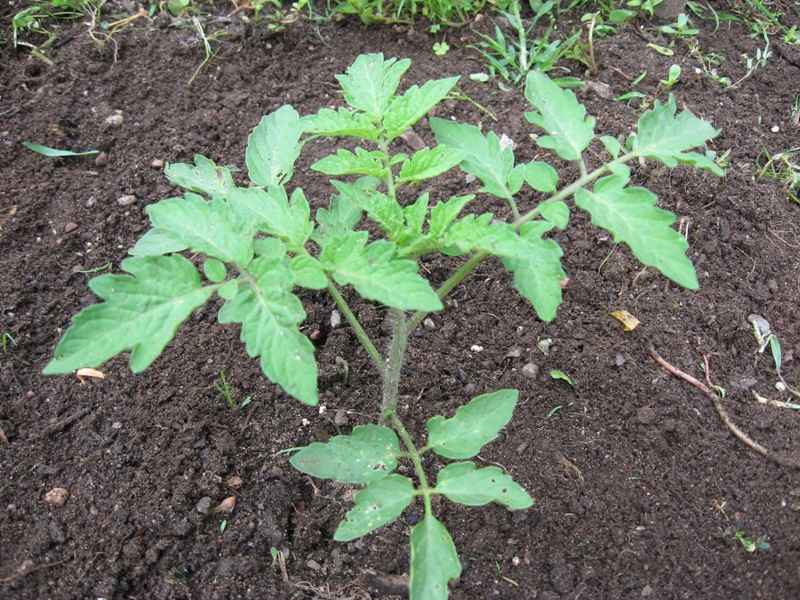
The general care scheme includes standard activities:
- Watering.
- Removing stepsons.
- Timely feeding.
- Disease control.
Landing rules
Choose a place for a tomato ridge away from buildings and fences. The shade during the day is bad for the taste of the fruit and the rate of development of plants. Mikado grows best on light soils. Loamy and sandy loamy soils are recommended.
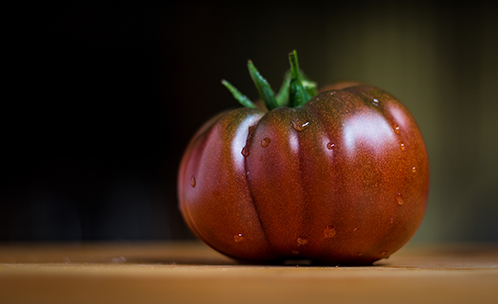
All Mikado varieties are tall, so the holes must be placed at intervals of 50 cm. Pick up stakes for the garter high, at least 2 m high. The main food in the form of organic matter (compost, humus) and mineral fertilizers is applied during digging. When planting, you can pour 1 - 2 handfuls of ash into the hole. If there is not enough space on the ridge, the bushes are planted in a checkerboard pattern.
Watering rules
Check soil moisture before watering. The top layer (5 cm) must be dry. Watering is always abundant. Surface watering damages tomato bushes.
There should be no stagnation of moisture - this can lead to an outbreak of late blight or provoke root rot. The greenhouse should be ventilated and the soil should be loosened after each watering. Beginners should be aware that tomato bushes do not need to be watered over the leaves, only at the root.
How to remove stepsons
Remove stepsons with clean hands without using scissors. Remove those stepsons whose size has exceeded 3 cm. The optimal size of the stepson for removal is 5 cm. It is better to leave a stump of 1 - 1.5 cm, which will delay the formation of a new stepson.
In Mikado tomatoes, all leaves below the first flower cluster must be removed... This can be done with scissors. Do not water the tomatoes on the day the leaves are trimmed.
We feed correctly
During the summer, Mikado tomatoes require fertilization. In the first half of summer, it can be organic:

- chicken droppings;
- mullein;
- grass.
On their basis, you can prepare infusions and water the bushes. When preparing chicken infusion, take 1 part of droppings and 12 parts of water. If a liquid fertilizer is prepared from a mullein, then 8 parts of water are taken for 1 part of the mullein. The herb is fermented by eye.
In the first half of summer, fertilizers containing nitrogen can stimulate growth.... It is convenient to use ammonium nitrate or urea. They are not used in the second half of summer. The nitrogen contained in them can cause excessive growth of branches, stepchildren and delay the ripening of fruits.
In the second half of summer, fruits are actively formed. At this time, plants do not need nitrogen, but phosphorus and potassium: one of the phosphorus-potassium fertilizers is applied at the root.
The scheme to follow:
- feed for the first time 2 weeks after transplanting into the ground;
- the second time - after 14 days;
- the third is when the fruits begin to form.
Disease prevention and control
To prevent fungal infection, use Bordeaux liquid.She treats seedlings a week before transplanting into the ground. In cool and damp weather, you can do without chemicals. Sprinkle tomato bushes with a solution of milk (1 part), water (10 parts), iodine (2 - 3 drops).
When the first signs of phytophthora appear, it is better to move from folk methods to modern methods. They are based on fungicides. Phytosporin found application among summer residents: it is safe for people and fights well against fungal infection.
Fungal spores multiply at a high rate in a humid environment. This must be remembered for those who grow tomatoes in a greenhouse. You can reduce the percentage of humidity in the greenhouse by regular ventilation and mulch from dry grass.
Hot red peppers may be needed in summer. Slugs and bears do not like him - the main enemies of tomato plantations. Pepper scattered around bushes repels pests.
Conclusion
All varieties from the Mikado series are invariably in demand, despite the low yield. The explanation is simple: the taste of the fruit is wonderful, which determines the choice and long-term popularity of Mikado tomatoes.

